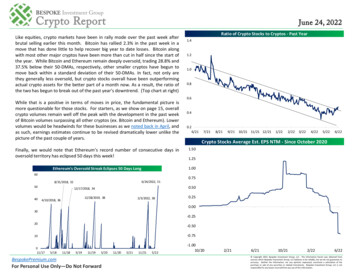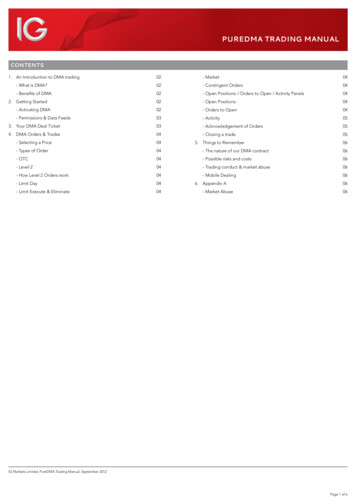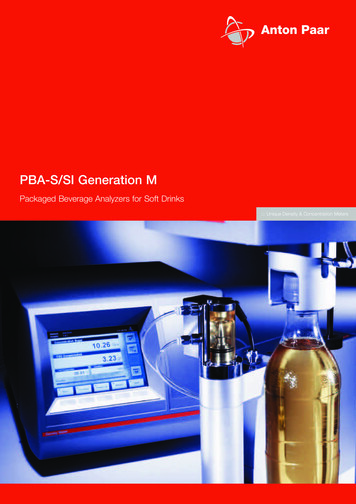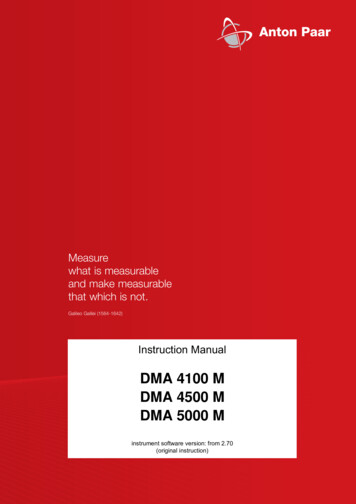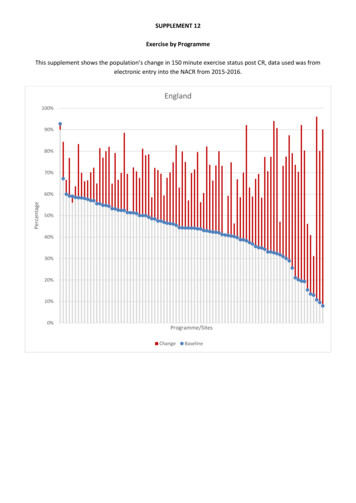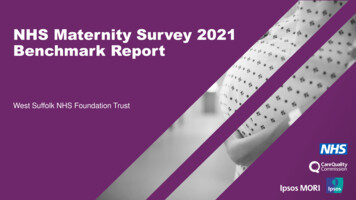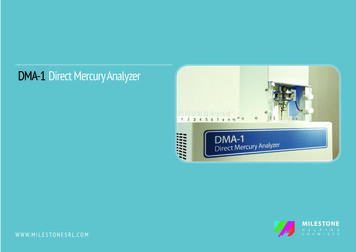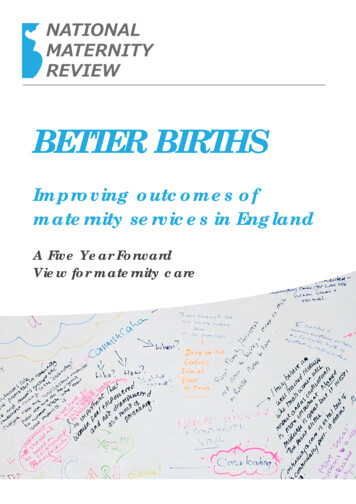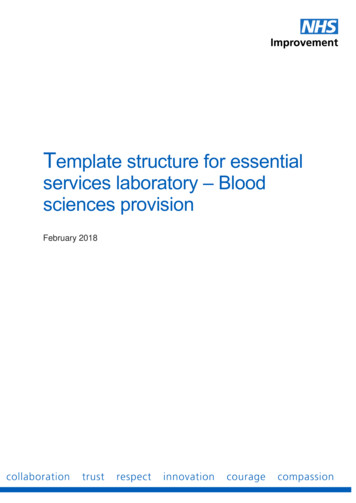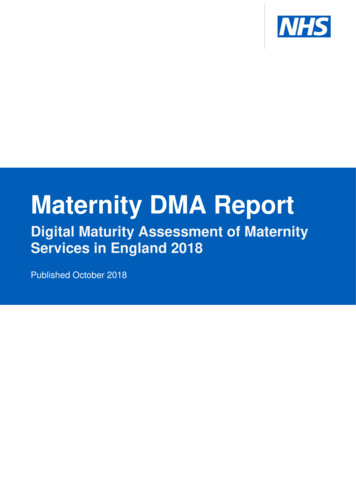
Transcription
Maternity DMA ReportDigital Maturity Assessment of MaternityServices in England 2018Published October 2018
Maternity DMA ReportForewordThe National Maternity Review, Better Births, emphasised the importance of the wholesystem that delivers coordinated care from different providers such as midwives, GP’s, andobstetricians over the course of a pregnancy and afterwards and the different places such assurgeries, midwife led units and hospitals which are part of the system; thus, the concept ofLocal Maternity Systems or LMSs. A similar concept underlies the development ofSustainability and Transformation Partnerships or STPs that are part of the new NHS.Indeed, the NHS is a system not just a service.A system requires everyone to work together and care needs to be coordinated. Nowhere isthis more important than in maternity services. For this to work everyone needs to shareinformation and for years this has been recognised by the Mother holding the paper recordthat she takes with her to wherever care or treatment is being provided. But the process iscumbersome, much information that is relevant is held by different providers and not readilyavailable to the Mother, the midwife, the GP or even the hospital never mind others who maybe involved such as social services the voluntary sector or mental health services. As ViceChair of National Maternity Review and the Stakeholder Council of the MaternityTransformation Programme Board, I am clear that the better use of technology and data isessential if we are to meet women’s expectations around choice and personalisation andalso free up professional time to practice, leading to safer and more effective care.The Digital Maturity Assessment (DMA) has been completed by 100% of maternity services,with the majority of returns being completed by clinicians. For the first time, we have acomplete picture of the digital maternity landscape across England - a baseline forimprovement at both a national and local level. It shows us how developed the foundationsare for maternity care to be at the forefront of a digital NHS. This has been a necessary firststep to achieve our ambition.Alongside this national report every Local Maternity System (LMS) has also been issued witha local report to help guide planning. This will facilitate joined up working on digital solutionswhich provides clinicians the information that they need to deliver high quality care, reducesthe reporting burden and delivers rich data for insight and improvement. All this is nowtechnically possible, it is our ambition to ensure that maternity is first in line to benefit fromopportunities created by new digital developments.National networks such as the LMS Digital Leader’s Forumand Digital Midwives Expert Reference Group have playedan important role. We should continue to build thiscommunity - connecting the people responsible for digitaltechnology in maternity services across the country.Sir Cyril Chantler, Vice-Chair,Maternity Transformation Programme BoardCopyright 2018 NHS2
Maternity DMA ReportStatement from the RCM and RCOGThere is no doubt that digital technology is fundamental to the way women receive maternitycare. Digital technology is evolving quickly, and so are the expectations of pregnant womenand their families. RCM and RCOG welcome this comprehensive and honest report as it setsthe benchmark across England, shining a light on good practice and highlighting theopportunities for development. Better use of technology and ability to share data not onlyhelps us to meet women’s expectations around choice and personalised care but can alsofree up professional time to practice; providing even safer and more effective care.The vast majority of the maternity digital maturity assessments were completed by cliniciansclosest to the women within maternity services. This provides us with another greatopportunity to hear the voices of the maternity staff, especially as midwives and obstetriciansplay such a pivotal role in driving the uptake and successful adoption of digital initiatives.Every maternity service in England submitted a maturity assessment. This overwhelmingengagement from maternity services demonstrates the growing appetite for making best useof digital healthcare. The opportunities presented by the emergence of new technologies hasthe potential to transform the relationship between a woman and her care providers. Thesechanges are a means to enhance the care we give and interactions we have with women, itshould not be seen as a barrier. RCM and RCOG are certain that clinicians will embraceinnovations which seek to enhance relationship-based care and drive up the quality andsafety for all women and families.Moving forward, we see the findings of this report as an opportunity to build upon ourPartnership working and continue to strengthen our networks and digital collaboration acrossthe country. We plan to see a rise in digital maturity amongst maternity services that willensure a sustainable and collaborative digital future benefitting services, clinicians andpregnant women.Mandy Forrester, Head of Quality and StandardsThe Royal College of MidwivesMr Edward Morris MD FRCOG, Vice President, Clinical QualityRoyal College of Obstetricians and GynaecologistsCopyright 2018 NHS3
Maternity DMA ReportContentsForeword2Introduction8Working with maternity services12How to use this report15What can I expect to find in this report?16National analysis179 emerging themes241. Digital leadership252. Maternity Voices Partnership323. Process mapping the maternity pathway414. Connectivity for community midwives465. What does a good system supplier look like?516. Data driven improvements in maternity services597. Business cases and business change: maternity digital hardware658. Myth busting and quick wins739. Our digital future83Closing Remarks96Copyright 2018 NHS4
Maternity DMA ReportAppendix A - Analysis by section: Content971. Strategic alignment992. Leadership1033. Resourcing1074. Governance1105. Records, assessments and plans1136. Orders and results management1227. Transfers of care1268. Medicines optimisation1339. Decision support13610. Remote and assistive care14211. Asset and resource optimisation14612. Standards15013. Business and clinical intelligence15314. Enabling infrastructure156Appendix B – Additional Resource1601.Clinical Safety Officer1612.National Maternity Survey Programme1633.Maternity apps research1654.NHS Apps Library1695.Digital strategies1716.Maternity Service Data Set (MSDS)1747.Service management1788.Summary Care Record1809.e-Prescribing and exemptions18110. Feedback in maternity services18511. Dual data entry18612. Social media in maternity services18913. Online booking forms19314. Independent providers194Copyright 2018 NHS5
Maternity DMA Report15. Digital maternity records19516. Cyber security197Appendix C – Average score by question198Appendix D – Business cases templates206Appendix E – Example process map for the obstetrics pathway207Appendix F – Breakdown of system supplier by maternity provider207Appendix G – Calculating scores208Appendix H – System supplier check list209Appendix I – Linking the emerging themes and the 14 sections209Copyright 2018 NHS6
Maternity DMA ReportQuick links: click to jump to the emerging themeCopyright 2018 NHS7
Maternity DMA ReportIntroductionIntroduction8Working with maternity services12How to use this report15What can I expect to find in this report?16Copyright 2018 NHS8
Maternity DMA ReportWhat digital maturity means for maternity servicesThe Maternity DMA allows us for the first time to measure how well maternity services inEngland are making use of digital technology. The outputs of the Self-Assessment will helpindividual organisations to identify key strengths and gaps in their provision of digitalservices. The analysis contained in this report provides an overview across the country ofthe progress maternity services are making in obtaining the benefits associated withadopting digital technology.The diagram below shows a high-level distribution of maternity services in England in termsof how well they are using digital technology. Level 4 is the highest level of digital maturityand Level 1 is the lowest.Figure 1: Maternity services categorised based on their overall scores in the 2018 DMA. Each 'figure' represents approx. 10trusts and ‘half figures’ approx. 5 trusts (this scoring approach is explained in the calculating scores section)Defining ‘digital maturity’Digital maturity is not only an indicator of how well a maternity service is currently usingdigital technology, but also a measure of how well prepared the people, processes andtechnology are for adopting new digital transformation initiatives. In order to build asustainable thriving digital service for the future, we need successful adoption of thesechange initiatives. This requires alignment of digital maternity strategy, leadership andculture to match with women’s needs and expectations.The reality for women experiencing care at each ‘Level’The application of digital technology has a real impact on the experiences for pregnantwomen accessing maternity services. Each of the four levels reflect a different experience forwomen and clinicians. Below, each of those levels is outlined in terms of what a woman islikely to experience:Copyright 2018 NHS9
Maternity DMA ReportTable 1 DMA 'Level' outlines – the service user perspectiveDMALevelTypical experience of using this serviceLevel 1Almost all my notes are in a paper format, I was given lots of paper leaflets.The midwives seemed busy typing information into PCs at every appointment,but I’m repeatedly asked the same questions. During my pregnancy I neveraccessed the Trust website for guidance and my midwife never referred me toany online resources.Level 2I might be able to access some online resources from the maternity service,but this doesn’t cover me throughout the full pregnancy pathway. It’s unlikelythat I can access my maternity notes digitally. Some maternity staff havemobile devices such as tablets, however paper notes are still a major part ofmy experience.Level 3I’m likely to have access to some online resources with a few maternityservices enabling me to view my maternity record digitally but not interact withit. Most maternity staff have mobile devices such as tablets, which allow themto access information about my pregnancy more easily. Paper plays a smallerrole.Level 4I’m offered a suite of online tools which cover my whole pathway. I am able tointeract with my maternity record in a way that is useful to me. All thesupporting information I need is online, but I’m able to contact my midwifethrough several channels, including digital means, should I need to. It’s likelythat I completed an integrated online booking form, which allows maternitystaff to digitally access all the information they need to support me. I feelsupported as part of an online community with other expectant parents. I don’thave to keep re-telling my personal circumstances unless I choose to.The benefits of having high digital maturityAs well as providing benefits directly to the women using the maternity services, digitaltechnology offers huge opportunities to enhance the working practices of maternity staff.Behind the scenes, technology when applied well should enable clinicians, enhancing theirpractice and freeing up their time to care. However, digital tools often aren’t used to their fullpotential and can end up becoming barriers or even created additional burden.The Wachter Report highlights the important role that clinicians must play in making newdigital initiatives a success. The report also highlights the barriers that must be overcome. Inorder for clinicians to feel the benefits of such initiatives, they need to be done for the rightreasons. Digital solutions are about enhancing existing process and practices not replacingthem.This report ultimately aims to baseline digital maturity and help drive-up the use oftechnology in the future. Higher levels of digital technology will help maternity staff andCopyright 2018 NHS10
Maternity DMA Reportmaternity services to deliver against the triple aim of better health, better care and bettervalue.Is there a potential link between digital maturity and the improvement of safety forboth women and babies? One of the main drivers behind many digital initiatives is anobjective of improving safety, therefore it is possible that there could be a correlationbetween digital maturity and safety. This is something that will require further research androbust evidence to prove. However, if a causational link is demonstrated then this couldbecome a strong incentive for maternity providers to invest in driving up their digital maturity.Potential for driving up digital maturity in the future“the future’s here it’s just not evenly distributed” – AnonAt a glance, the majority of maternity providers in England are spread across levels 2 and 3.This largest group of trusts are making a good start in adopting digital technologies; later inthe report we will investigate the different hurdles trusts must overcome to progress in drivingup their digital maturity. However, there is a great opportunity for us to share learning acrossthe system so that those more digitally mature maternity providers can share their learningwith others. Only a minority of maternity providers have very low digital maturity, and theseare the organisations who stand to gain the most from the recommendations made in thisreport.Copyright 2018 NHS11
Maternity DMA ReportWorking with maternity servicesBackgroundBetter Births established the important role technology plays in transforming maternityservices. Recommendations included electronic health records, sharing information digitally,online resources, understanding the digitally ‘savvy consumers’ as well as investing in theright software, equipment and infrastructure.The Maternity DMA was commissioned at the end of 2017 with an aim to conduct a nationalassessment during 2018. The Maternity DMA would create a baseline to help evidence thecurrent state of digital maturity across England and to ensure that the required level ofleadership, infrastructure and capabilities exist to enable the Better Births recommendationsaround digital technologies to be delivered.The questions in the Maternity DMA attempt to capture the unique challenges facingmaternity services and the issues raised in Better Births, whilst remaining aligned to the NHSEngland methodology for assessment. The Assessment measures maturity against thefollowing key themes: Readiness: are providers able to plan and deploy digital services? Capabilities: do providers have staff with the digital skills they need? Infrastructure: do providers have the right technology in place?High engagement allows for LMS driven approach and outputsvaluable for maternity providersThe Maternity DMA closed in July 2018 with input from 135 maternity providers in England.(including two independent providers) The information has been analysed and the outputshave been published following approval at the MTP Board on the 17th October.The fact that 100% of the maternity providers approached completed the assessmentindicates that engagement around this area is high. There is an appetite at both provider andLMS level to identify and overcome any barriers around implementing new technologies.This report is intended to provide recommendations that are useful to individual maternityproviders and at a wider LMS level, a collaborative approach to regional issues is likely to bethe best way to drive up digital maturity going forward.Maternity DMA snapshot: LMS wide planningBLMK LMS (Bedfordshire, Luton and Milton Keynes): are a great example of this kindof approach to collaborative working. The LMS ran a joint planning session to feed theMaternity DMA data from each maternity provider into wider regional planning.Copyright 2018 NHS12
Maternity DMA ReportMaternity DMA outputsThe Maternity DMA aimed to deliver five key outputs: National Maternity DMA report: a single report showing the ‘state of the nation’, highlevel findings and first recommendations from the DMA data. LMS DMA reports: reflecting the ‘national report’, each of the 44 LMSs will receive areport containing focused analysis and recommendations relevant to the MaternityServices in their geography. (LMS DMA reports are stored on the NHS England MTPsite, for a copy of your report contact England.maternitytransformation@nhs.net). Maternity DMA data: this data source will be available to support certain nationalinitiatives and will be stored so that future repetitions of the Maternity DMA can trackthe progress of maternity providers and help evidence their improvements. Maternity DMA toolkit: a website sharing actionable resources for stakeholders tobegin improving their digital maturity. This will be an evolving resource building uponthe areas of development identified in the national report.Establishing powerful networks: Creation of a network for regional digital leaders: known as the LMS DigitalLeader’s Forum, NHS Digital has identified and brought together a digital leader fromeach of the 44 LMSs to form a peer network, to collaborate on DMA matters such asidentifying common challenges, co-authoring guidance and sharing best practice. Thisgroup will be useful going forward in efforts to drive up digital maturity. Creation of a network for digital midwives: known as the Expert Reference Groupfor midwives. Formed of digital midwives from across the country, the group acted asa two-way conversation allowing the maternity DMA to feed in requirements from frontline clinicians.Scope of the Maternity DMA projectThis Maternity DMA project was initiated in December 2017. The platform and questionswere developed and tested over the subsequent months until the assessment went live inApril 2018. Information was collected from maternity providers between April and the end ofJune. Subsequently the information was analysed until the reports were ready to beapproved and published in October 2018. The final report was approved 17 October by theMTPB and published the following day, 18 October. The aim was to turn the analysis aroundquickly in order to ensure the information was still up to date and relevant.Copyright 2018 NHS13
Maternity DMA ReportKey Milestones:Draft, test, build Mat.DMA: Dec 17 – March18DMA datacollection:April – June18Data analysis&engagement:July – Sept 18DMA Reportspublished:October 18Driving up DMphase begins:October 18Next steps for the Maternity DMA project teamFor more information about the ‘Driving up digital maturity phase’ please see Digital Maturitysection.Key stakeholders and resourcesThe structure for the Maternity DMA questions were based upon previous pieces of work byNHS England. The project team maintained strong links with teams at NHS England,including the Maternity Transformation Programme and it’s various workstreams. Othergroups engaged with during this piece of work include: Professional bodies: Royal College of Midwives, Royal College of Obstetricians andGynaecologists. Representative groups: Senior MVP engagement, surveys with women and face-toface representatives. Other national organisations and initiatives: NHS England, NHS Improvement,NHS Digital (Services, Projects and Programmes). Regional and local engagement with clinicians: Digital leaders appointed in all 44LMSs (75% of the Maternity DMA’s were completed by midwives within the 135services).Copyright 2018 NHS14
Maternity DMA ReportHow to use this reportThis national maternity DMA report aims to provide maternity services with the insight andresources to aid local planning and support national planning for the adoption of digitaltechnologies. The report is supported by 44 LMS reports, designed to be used in conjunctionwith one another (LMS DMA reports are stored on the NHS England MTP site, for a copy ofyour report contact England.maternitytransformation@nhs.net). The LMS reports show thedetailed analysis at maternity provider level and compare it to LMS and national averages.In Appendix A, each of the 14 sections of the DMA is explored in detail, a format mirrored inthe LMS reports. The detail in the appendix of this report is not intended to be read end-toend, rather to be used as a resource to build on the specific topics identified as strengthsand weakness in this LMS DMA report.The raw maternity DMA data for all maternity providers is available as an embedded filewithin their respective LMS report should they wish to do any further analysis.Figure 2: Maternity DMA data – available in three forms: raw data, LMS reports and National Maternity DMA reportCopyright 2018 NHS15
Maternity DMA ReportWhat can I expect to find in this report?The report is broken down into four sections:Link to sectionIntroductionDescriptionDetails the scope of the project and gives a brief explanation of theMaternity DMA, providing background, detailing the process andproject drivers.National analysisThe scores from the 135 providers have been analysed and brokendown geographically and into the 14 different sections of theMaternity DMA. The analysis explains why particular themes wereexplored and reviews the scores for individual questions. Theanalysis tries to showcase particular maternity providers who havehigh levels of digital maturity and begins to suggest potential actionswhich may help overcome certain digital maturity issues in maternityservices.9 emerging themes 9 emerging themes have been identified which represent thecommon challenges faced by a significant number of maternityproviders. The themes are also aimed at addressing the root causeof wider digital maturity issues. Each theme aims to signpost topotential resources and solutions which may help maternity servicesstart to address their digital maturity challenges. The themes aresupported by evidence from the national analysis.Additional resources A number of other topics have been explored within this report. Theresources collected in this section are useful tools to boost digitalmaturity, however, it’s possible that many of them will be relevant toa smaller group of maternity providers.Copyright 2018 NHS16
Maternity DMA ReportNational analysisNational analysis17Overall digital maturity . 18Overview of the country by LMS . 19Maternity DMA questions and data caveat . 20Calculating scores . 20Categories and sections . 21Overview of sections . 23Detailed analysis of national scores . 23Copyright 2018 NHS17
Maternity DMA ReportOverall digital maturityAs per the ‘4 levels of digital maturity’, maternity providers across the country are at a rangeof different levels of digital maturity. The analysis is the coming section looks at data both ata maternity provider level and LMS level. Where the questions have been converted into ascore out of 100, an explanation of how this was achieved follows in this section.The following key statements help set the national scene: Overall average score was 51 out of a potential 100: This is great test of whetherthe right questions were asked in the Maternity DMA, an average score of close to 50shows that the self-assessment was well designed. The intention was to for thequestions to cover both the basic building blocks and more aspirational topics. 51 is agood starting point, we can now aspire to move the national picture towards the 100. Some trusts scored 0 on sections whilst others scored 100: The variation acrossthe country is significant, against the same set of questions some providers scorethemselves as close to full digital maturity whilst others are scoring 0. A greatopportunity to share learning. The highest scoring ‘DMA section’ averaged 77, the lowest 23: The sections aredetailed later in this analysis; however, it would appear the maternity providers areoften doing well on the same elements but are also encountering challenges in thesame areas. This allows a great opportunity for the national teams and networks tofocus on solving those common issues. Low and high areas of digital maturity are distributed across the country: TheMaternity DMA proves that there is little to no North/South divide in terms of digitalmaternity. Each region has leaders and followers, providing the opportunity for truststo develop by partnering with the digital leaders in their local areas.Copyright 2018 NHS18
Maternity DMA ReportOverview of the country by LMSThere are 44 LMSs in England. Figure 2 shows a national picture of digital maturity by LocalMaternity System (LMS). Those LMSs within the lowest scoring quartile (the bottom 11) foroverall digital maturity are shown in white with the highest scoring quartile (the top 11) shownin dark blue. An interesting observation is how widely distributed by geography the differentlevels of maturity are, to the point where all low maturity LMS share a border with a highmaturity LMS.Figure 3: Overall digital maturity in England (LMS comparative data has not been published at this time)Copyright 2018 NHS19
Maternity DMA ReportMaternity DMA questions and data caveatThe Maternity DMA consisted of more than 200 questions formulated by clinicians and spansboth the acute and community setting. The framework adopted was taken from the NationalDigital Maturity Assessments for trusts run by NHS England and is structured to represent‘good practice’. Analysis at national level of each section and the questions it contained areavailable in Appendix A, along with an explanation as to why each topic is important to digitalmaturity and what steps can be taken to improve in this area.Types of questions used in the assessmentA range of question styles were used in the assessment, including: Questions asking providers to assess themselves on a five-point scale from ‘agreecompletely’ to ‘disagree completely’ (known as the Likert scale) against a range ofstatements that refer to the readiness, capability and infrastructure when consideringdigital technology. Quantitative questions requiring a response against a numeric range (the ‘whatproportion’ type questions). These were used to provide a better insight into thecurrent digital maturity landscape. Explicit questions about the maternity providers, to better understand some of thespecifics e.g. what system supplier is used, do you provide a digital version of thehand-held record, etc. Free text questions, which allowed the users to add further detail and context whereappropriate.It should also be noted that the Maternity DMA is a ‘self-assessment’ and reflects a point intime. This means that it is mainly based on the opinions of those who complete it, rather thandemonstrable fact. As time passes, the answers provided in the Maternity DMA will becomeout-dated.Calculating scoresThe responses were then converted into scores, with 100 being the most digitally matureand 0 being the lowest, to allow comparative analysis to be carried out and an overall ‘digitalmaturity score’ to be calculated. Please see the calculating scores section for further detail.Some important points to note regarding the analysis: The Maternity DMA is a ‘self-assessment’– This means that it is mainly based onthe opinions of those who complete it, rather than pure fact. As a result of this, theremay be inaccuracies or inconsistencies compared with what actually happens. Handing of ‘N/A’ values – All questions in the Maternity DMA have ‘N/A’ offered as apotential response. Where this value has been selected, this question has beenexcluded when calculating national averages, i.e. it is excluded from the denominator.This ensures that where a question is not relevant to a particular provider, the nationalCopyright 2018 NHS20
Maternity DMA Reportaverage is not distorted by including these responses. Where a question has been leftblank, the response has also been treated the same way. Handling of ‘Don’t know’ values – All questions in the Maternity DMA have ‘Don’tknow’ offered as a potential response. Where this value has been selected, unlike the‘N/A’ responses, these values have been included in the national averagecalculations, as not knowing something implies a lack of digital maturity. Calculating ‘proportional’ averages – A number of questions in the Maternity DMAask for a quantitative response (i.e. ‘what proportion’ of something happens). In termsof the aggregated analysis of these questions, it is important to understand that this isan average provider score based on all the responses. There has been no weightinghere depending on the size of the provider or the number of women birthed.Categories and sectionsThe Maternity DMA is split into three categories: Readiness considers whether providers have high level strategic and leadershipstructure in place to deliver paper-free care Capabilities considers whether the digital technologies and capabilities are in placeto deliver paper-free care Infrastructure considers whether the technical enablers are in place to deliver paperfree careEach of the themes are broken down by section. The figure below shows each of thesections by themes with a short summary of what each section focuses on.Copyright 2018 NHS21
Maternity DMA ReportFigure 4: M
Digital technology is evolving quickly, and so are the expectations of pregnant women . Orders and results management 122 7. Transfers of care 126 8. Medicines optimisation 133 9. Decision support 136 10. Remote and assistive care 142 11. Asset and resource optimisation 146 12. Standards 150 13. Business and clinical intelligence 153
